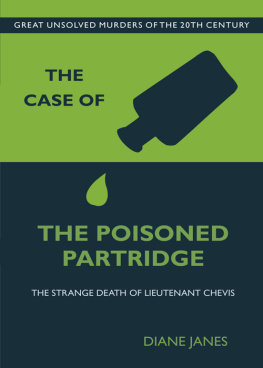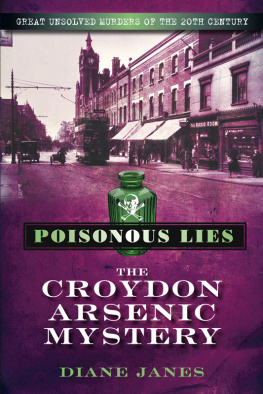For Tim.
CONTENTS
T his book would not have been possible without the generous co-operation of Surrey Police in allowing me access to their files on the case. I am also grateful for access to material at Surrey History Centre, the National Archives, the British Library both at St Pancras and Colindale, Bournemouth Library Local Studies, Eastbourne Library Local Studies, Poole History Centre, the Wellcome Collection, the Royal College of Veterinary Surgeons Library, where staff were particularly helpful and welcoming, and to Sandi at Aldershot Garrison for providing information from their records.
I would like to record my thanks to relatives and descendants of those involved in the case for talking with me, including David Braham, Patricia Beamish, and members of the Keating family, but principally Charles Jackson and Major Bill Chevis, who gave generously of their time and without whom the book would have been the poorer.
This brings me to the usual suspects whose input, interest, enthusiasm and encouragement is beyond price: Jane Conway-Gordon, Matilda Richards, Erica and Peter Woolley, and of course my husband, Bill.
Diane Janes, 2013
CHAPTER ONE
Oliver Goldsmith, 1766
I n common with many of the officers stationed at Blackdown Camp in the 1930s, Lieutenant Elwin Evered and his wife Margaret were in the habit of keeping a pet at their bungalow. When their spaniel bitch came into season on 2 June 1931, Lieutenant Evered put her into kennels at the Farnborough Dogs Home for three weeks, returning to collect her at noon on Saturday, 20 June. The dog appeared to be in perfect health and was allowed in and out of the bungalow as usual, but later that evening when she failed to return home, the Lieutenants batman was despatched in search of her. He returned a few minutes later, carrying the dog in his arms. She was in a distressed state, unable to stand, and within fifteen to thirty minutes the unfortunate animal had died.
The Evereds immediately suspected that their pet might have consumed some sort of poison suspicions which would have been significantly reinforced had they been aware of an unfolding tragedy taking place a matter of a few dozen yards away for while they mourned their dog, frantic attempts were being made to save the life of Elwin Evereds brother officer and close neighbour, Lieutenant Hugh Chevis, whose agonies lasted rather longer than the spaniels, although the outcome was the same. At 9.45 the next morning Lieutenant Chevis was pronounced dead at Frimley Cottage Hospital, with the cause of death stated as strychnine poisoning. The police were summoned soon afterwards and so began the investigation into what has become known as The Case of the Poisoned Partridge.
It was not until 1946 that George Orwell penned his famous and oft quoted essay, The Decline of the English Murder, It is more likely, however, that the public already had a sensational poisoning case to enjoy in the shape of Annie Hearn, whose trial for the murder of Alice Thomas was in full swing when news of Lieutenant Cheviss death broke. (Mrs Hearn was on trial for poisoning her friend with arsenic, using the unlikely medium of salmon sandwiches as her weapon.) In addition to the distraction provided by Mrs Hearn, several other headline-grabbing murders took place in the summer of 1931, including that of Mrs Annie Kempson in Oxford on 3 August a brutal attack which sparked a nationwide manhunt and culminated in the apprehension of the killer in Brighton twelve days later.
Whatever the reason, The Case of the Poisoned Partridge although essentially the third in a hat-trick of classic unsolved cases in 1931 never quite captured the public imagination in the same way that its Croydon, Liverpool and Otterburn counterparts did. Yet the case had many of the crucial factors which Orwell would go on to identify as from a News of the World readers point of view, the perfect murder. According to the premise set out in The Decline of the English Murder, the setting should be a domestic one and the main protagonists belong to the respectable middle classes. For preference the means should be poison and if at all possible the motive should involve guilty passions, or the damaging possibility of scandal and divorce. The murder itself should appear to display a high level of detailed planning and the utmost cunning in its execution. Not only did the Chevis case have all of these, but there was another facet which Orwell failed to mention in his list one which was a virtual prerequisite of the fictional murders which formed an equally significant part of the nations reading matter at the time the hint of a mysterious outsider, bent on some kind of terrible revenge. No standard detective novel published during the period now categorised as the Golden Age of crime fiction would have been complete without at least one such character among its circle of suspects but in spite of possessing all of these promising components, the Poisoned Partridge story was slow to take off and after a brief flurry of excitement it vanished from the national dailies and was all but forgotten, save for the occasional anodyne chapter in one of the true-crime compendiums which appeared from the 1930s onwards.
Since the compilers of each successive murder compendia were apparently content to derive their information from one of their predecessors, unsubstantiated assumptions about the case were repeated, while key facts often went unchecked. The focus of these retellings was invariably a mysterious telegram received on the day of Lieutenant Cheviss funeral, which bore the message Hooray Hooray Hooray. The Hooray telegram and the identity of its untraced author provided such a rich source of speculation, that in several accounts the known participants in the drama are almost overlooked, with Lieutenant and Mrs Chevis dismissed as an ordinary army officer and his wife of six months, happily married, with no obvious enemies such a commonplace couple what could there possibly be to say about them? Mrs Chevis (who demonstrably could not have sent the telegram) is accorded such a minor role in events that some accounts do not even bother to provide her first name, still less the information that she was an immensely wealthy woman and (as in all domestic murders) the most obvious suspect. In all but ignoring Lieutenant and Mrs Chevis, however, these authors have done their readers a grave disservice for Hugh and Frances Chevis were very far from being an ordinary couple and The Case of the Poisoned Partridge is worth far more than a routine regurgitation of half-known facts.
CHAPTER TWO
ONE OUGHT NOT TO GIVE
STRYCHNINE TO A RAT!
Frances Chevis, 1931
A rsenic has sometimes been called The King of Poisons and while cases of murder by arsenical poisoning have never been commonplace, they occurred with reasonable frequency throughout the Victorian period and well into the twentieth century. One of the supposed attractions of arsenic as a weapon was the possibility that the fatal symptoms might be confused with some naturally occurring gastric illness. Indeed it was the belief of several leading forensic experts, including Sir William Wilcox, that numerous cases of arsenic poisoning were going undetected in the first decades of the twentieth century, and a significant proportion of those tried for murdering their relatives with arsenic only appeared before the courts in the wake of an exhumation their assumed victim having originally been buried following certification of death by natural cause.
Suspicious deaths by strychnine were far less common not only was strychnine less abundantly available (by contrast there appears to have been scarcely a patent weedkiller sold in Britain during the 1920s and 30s which did not contain arsenic), but the symptoms of strychnine poisoning were sufficiently distinctive that even doctors who had never previously encountered a case were likely to recognise them.
Next page












